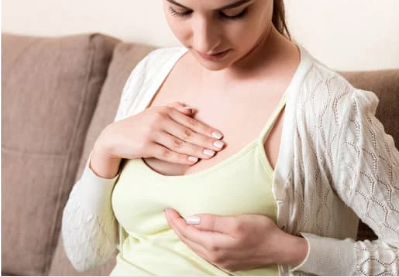Nipple and Breast Pain from Vasospasm
One of the most frustrating parts of breastfeeding for many women is the pain that can come along with it! While some tenderness can be expected from the new, high stimulation levels on a sensitive part of your body, if a latch feels painful or pinchy, it can be a sign that the baby is on improperly or too shallow, causing damage to the nipple. Nearly 80% of women report some degree of nipple pain in the first few days of breastfeeding, but persistent nipple pain beyond the first few days or weeks can indicate something isn’t quite right.
What is Vasospasm?
Vasospasm occurs when blood vessels contract abnormally, resulting in impaired blood circulation, which can be quite painful. It often presents with color changes of the nipple, such as blanching (turning white) or purple, along with sharp, shooting pain in the nipple, breast, or sometimes both. It is often caused by an incorrect latch cutting off circulation to the nipple but can also result from pre-existing disorders such as Raynaud’s phenomenon or rheumatoid arthritis.
Another characteristic of vasospasm is nipple pain with temperature changes, such as getting out of a hot shower or when in cold weather. Often, women report pain after or between breastfeeding sessions, having no issue when the baby is latched.
Correct Latch
In case an incorrect latch is the reason blood flow is being cut off to the nipple, you should have a board-certified lactation consultant check the way the baby is latching to the breast. Your nipple should be round when the baby is done feeding- if it is compressed or misshapen, this is another sign they may not have the optimal attachment. Signs of a good latch include a wide gape of the mouth, asymmetrical alignment, a sensation of deep tugging rather than pinching, and the baby’s lips being turned out.
Keep them Warm!
When the baby's warm mouth comes off the breast, and your wet nipple hits the cold air, this can induce painful vasospasms. Try covering your nipple with your warm hand, or a heating pad turned on low for a few minutes post-feed before re-dressing to minimize drastic temperature changes.
Massage and Stretching
Providing massage to the pectoral muscles for a minute or two after a feeding session can help to promote blood flow to the breasts and ease discomfort. The aim is to massage the muscles above the breast, not the breast tissue itself, as new research suggests that deep breast tissue massage can cause inflammation and is not recommended.
Various chest, shoulder, and neck stretches can also be helpful between breastfeeding sessions to promote elasticity and circulation in the muscles around the breasts. It’s also important to try and keep the neck and shoulders relaxed when feeding to avoid tension from uncomfortable positioning. It’s always helpful to get yourself comfortable first, bring the baby to you, and prop your baby up with plenty of support to avoid leaning down to reach them.
Supplements
Some women report improved symptoms when taking a B vitamin complex and magnesium supplement to help relax muscles and blood vessels. There are also prescription medications that may be helpful, but these come with side effects and should only be used for a short time with careful follow-up with your healthcare provider.
If you think you or someone you know may be suffering from persistent breast or nipple pain from vasospasm or something else, set up a time to chat with one of our international board-certified lactation consultants. You don’t have to rely on Dr. Google, our trained specialists are here to help you through your unique circumstances!
Resources
- Miranda L. Buck, Lisa H. Amir, Meabh Cullinane, Susan M. Donath, and for the CASTLE Study Team.Nipple Pain, Damage, and Vasospasm in the First 8 Weeks Postpartum.Breastfeeding Medicine.Mar 2014.56-62.http://doi.org/10.1089/bfm.2013.0106
- Mitchell, K. (2022). Academy of Breastfeeding Medicine Clinical Protocol #36: The mastitis ... Academy of Breastfeeding Medicine. Retrieved October 2, 2022, from https://www.bfmed.org/assets/ABM%20Protocol%20%2336.pdf


